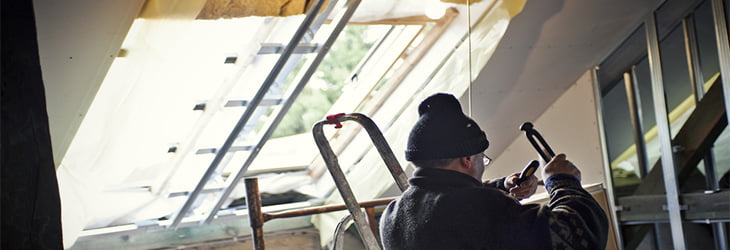Safety when working in lofts
Posted on 25th Apr, 2016 | By Lorretta Tatham
Whether you’re renovating a loft and turning it into an extra room or you’re just carrying out some general household maintenance in the loft space, it’s important to stay mindful of the dangers. The potential hazards in lofts can lead to serious slips, trips, and falls, which is why today we’re sharing our top safety advice with you today…
Common jobs in the loft

Lofts are accessed for a number of reasons by both homeowners and tradespeople. While jobs vary, there are health and safety risks with all of the below:
- Loft conversions
- Repairs and access to household equipment in the loft – such as boilers, extraction fans, smoke detectors, power and data cables, and much more.
- Cavity wall and loft insulation
- General DIY, household clearing and sprucing
Risk factors

Common risks associated with the jobs mentioned above include:
- Falls from a height
- Trips and slips
- Falling through skylights, old wooden boards, and poorly maintained surfaces
- Working with insulation materials
- Working in a confined space
Staying safe

As with all jobs that carry danger, risk assessments are key. Employers and managers are required to assess associated risks with working in a loft and developing a safe system of work, while employees should also assist with assessing risks. This all ties in with the Work at Height Regulations 2005, which require employers to ensure that work at height is properly planned, supervised, and carried out in a safe manner.
Once risks have been identified and safe working solutions put in place, it’s important that all employees comply with the system of work identified. Should further problems occur, or any incidents take place, it must be reported.
Other requirements needed to ensure safety include:
- A suitable loft hatch of 726mm x 566mm (the regulated size) to allow ease of access to the loft space
- Use of a strong, purpose-built loft ladder used in the proper way. Take note of maximum loads, assess the ladder for faults before use, and take your time
- Use of a safety rail when projects are being completed in the loft. This will help prevent falls
- Safe, secure grounding – a purpose-built platform may be required
- Adequate lighting
- Tidy workspace with no trip hazards – for example, trailing leads
A tip about insulation

If you’ve got fiberglass insulation in your loft, do take precautions to protect yourself from exposure. Exposure may cause health complications including skin irritation and eye irritation. What’s more, the inhalation of fiberglass particles has also been reported to cause cancer and lung problems.
Sign up to a training course
According to the Working at Height Safety Directive, working in loft space also counts as working at a height. Loft work comes with a real risk of falls – often due to a false sense of security. With this in mind, it may be worth improving your knowledge on working safely from a height with our Work at Height training course. During the course, we’ll give you all the information you need to help you to avoid accidents and stay safe when working from a huge range of heights.
To find out more about our safety training courses, contact our Course Enquiries team today on 01282 615517.




